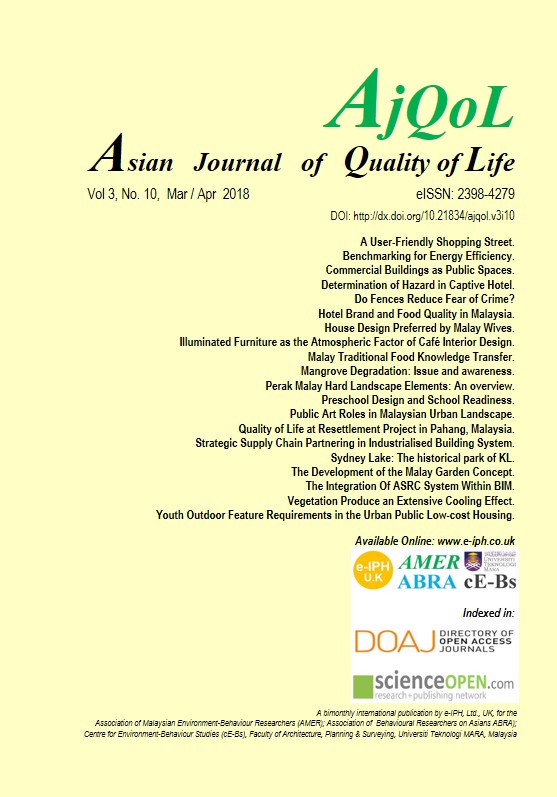Do Fences Reduce Fear of Crime
Main Article Content
Abstract
The Roadmap of Government Transformation Program 2010 reported that the sense of fear of crime among Malaysians is quite high which is 89 percent. So, the questions is, do they feel safe without fence? Therefore, this paper seeks on the neighborhood with no fence to identify the sense of safety and fear of crime (FOC) among residents. The result indicates that longer resident living in residential areas is significant with perceptions of crime (POC) in the neighborhood (p = 0.00). The more people go out at night is also significant with POC in the neighborhood (p = 0.012).
Metrics
Article Details
License
Copyright (c) 2018 Siti Rasidah Md Sakip, Norhafizah Abdul Rahman, Nadiyanti Mat Nayan

This work is licensed under a Creative Commons Attribution-NonCommercial-NoDerivatives 4.0 International License.
References
Aldrin, A. (1999). Crime Landscape: The Relationship of Victimisation and Fear of Crime With Residents' Territorial Functioning in High and Low Crime Rate Estate in Sheffield University of Sheffield, U.K.
Austin, D. M., Furr, L. A., & Spine, M. (2002). The Effects of Neighborhood Conditions on Perception of Safety. Journal of Criminal Justice, 30, 417-427. DOI: https://doi.org/10.1016/S0047-2352(02)00148-4
Banks, M. (2005). Spaces of (in) Security: Media and Fear of Crime in a Local Context. Crime, Media, Culture, 1(2), 169-187. DOI: https://doi.org/10.1177/1741659005054020
Bannister, J., & Fyfe, N. (2001). Introduction: Fear and the City. Urban Studies, 38(5-6), 807-813. DOI: https://doi.org/10.1080/00420980123505
Day, K. (2001). Fear of Crime and The Physical Environment. In A. Z. D. Brennan (Ed.), Safescape: Creating Safer, More Liveable Communities Through Planning & Design. United States America: American Planning Association.
Ferguson, K. M., & Mindel, C. H. (2007). Modeling Fear of Crime in Dallas Neighborhoods: A Test of Social Capital Theory. Crime & Delinquency, 53(2), 322-349. DOI: https://doi.org/10.1177/0011128705285039
Grabosky, P. N. (1995). Fear of Crime and Fear Reduction Strategies. Australian Institute of Criminology. DOI: https://doi.org/10.1080/10345329.1995.12036675
Harang, M. (2003). The Improvement of the Quality of Life in Residential Areas: The Policy Treeo. Document Number)
Hipp, J. R. (2010). Resident Perceptions of Crime and Disorder: How Much is "Bias", and How Much is Sosial Environment Differences? American Society of Criminology, 48(2), 475-508. DOI: https://doi.org/10.1111/j.1745-9125.2010.00193.x
Joseph, J. (1997). Fear of Crime Among Black Elderly. Journal of Black Studies, 27(5), 698-717. DOI: https://doi.org/10.1177/002193479702700507
JPBD. (2009). Draf Akhir Laporan Teknikal 'Gated and Guarded Community'. Kuala Lumpur: MN Consulto. Document Number)
Lee, M. (2001). The Genesis of 'Fear of Crime'. Theoretical Criminology, 5, 467-485. DOI: https://doi.org/10.1177/1362480601005004004
Lewis, D. A., & Salem, G. (1980). Community Crime Prevention: An Analysis of A Developing Strategy.Unpublished manuscript, North-western University.
M. Hedayati Marzbali, A. A., N.A. Razak & M.J. Maghsoodi Tilaki. (2011). Using Hotspot Mapping to Understand Spatial Patterns of Burglary in Residential Land Use: A Case Study of Penang. World Applied Sciences Journal, 13(8), 1948-1958.
Merrick, T. (1989). World population in transition Population Bulletin, 41.
Merry, S. E. (1981). Urban danger: Life in a neighborhood of strangers. Philadelphia: PA: Temple University Press.
Nasar, & Fisher, B. (1993). 'Hot Spots' of Fear and Crime: A Multi-Method Investigation. Journal of Environmental Psychology, 13, 187-206. DOI: https://doi.org/10.1016/S0272-4944(05)80173-2
Newman, O. (1972). Crime Prevention Through Urban Design Defensible Space. New York: The Macmillan Company.
Nunnally, J. C., & Bernstein, I. H. (1994). Psychometric Theory. New York: McGraw-Hill.
O'Shea, T. C. (2006). Physical Deterioration, Disorder, and Crime. Criminal Justice Policy Review, 17(2), 173-187. DOI: https://doi.org/10.1177/0887403405280942
Pain, R. (2000). Place, social relations and the fear of crime: A review. . Progress in human geography, 24(3), 365-387. DOI: https://doi.org/10.1191/030913200701540474
Pallant, J. (2005). SPSS Survival Manual; A Step by Step Guide to Data Analysis Using SPSS for Windows. Sydney, Australia: Allen & Unwin.
Perkins, Wandersman, A., Rich, R. C., & Taylor, R. B. (1993). The Physical Environment of Street Crime: Defensible Space, Territoriality and Incivilities. Journal of Environmental Psychology, 13(1). DOI: https://doi.org/10.1016/S0272-4944(05)80213-0
Perkins, Weeks, J. W., & Taylor, R. B. (1992). The Physical Environment of Street Blocks and Resident Perceptions of Crime and Disorder: Implicatons for Theory and Measurement. Journal of Environmental Psychology, 12(1), 21-34. DOI: https://doi.org/10.1016/S0272-4944(05)80294-4
Putrajaya, P. (2009). Laporan Pemeriksaan; Draf Rancangan Struktur Putrajaya. Putrajaya: Perbadanan Putrajayao. Document Number)
Reid, S. T. (2000). Crime and Criminology (Ninth ed.). U.S: McGraw-Hill Higher Education.
Renauer, B. C. (2007). Reducing Fear of Crime: Ctizen, Police or Government Responsibility? Journal Police Quarterly, 10(1), 41-62. DOI: https://doi.org/10.1177/1098611106286894
Roh, S., & Oliver, W. M. (2005). Effects of Community Policing Upon Fear of Crime Understanding The Causal Linkage. An International Journal Police Strategies & Management, 28(4), 670-683. DOI: https://doi.org/10.1108/13639510510628758
Rollwagen, H. (2014). The Relationship Between Dwelling Type and Fear of Crime. Environment and Behavior, 1-23.
Ross, C. E., & Jang, S. J. (2000). Neighborhood Disorder, Fear, and Mistrust: The Buffering Role of Social Ties with Neighbors. American Journal of Community Psychology, 28(4), 401-420. DOI: https://doi.org/10.1023/A:1005137713332
Stephen, F., Emily, G., & Jonathan, J. (2007). Theorising the Fear of Crime: The Cultural and Social Significance of Insecurities about Crime. Institute of Law, Politics and Justice, Keele University, Staffordshire, England, & Methodology Institute, London School of Economics, Houghton Street, London.
Welsh, B. C., & Hoshi, A. (2002). Communities and Crime Prevention. In Evidence-Based Crime Prevention. New York: Routledge.
Wilcox, P., Quisenberry, N., & Jones, S. (2003). The Build Environment and Community Crime Risk Interpretation. Journal of Research in Crime and Delinquency, 40(3), 322-345. DOI: https://doi.org/10.1177/0022427803253801
Wilson-Doenges, G. (2000). An exploration of sense of community and fear of crime in gated communities. Environment and Behavior, 32(597-611). DOI: https://doi.org/10.1177/00139160021972694
Wong, T. C., B.J.Shaw and K.C.Goh. (2006). Challenging sustainability: Urabn development and change in Southeast Asia (2nd Edition ed.). California: Marshall Cavendish Academic.




